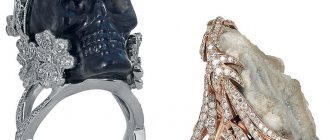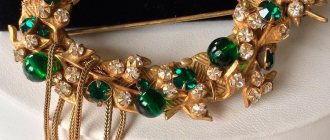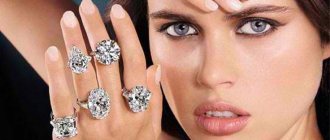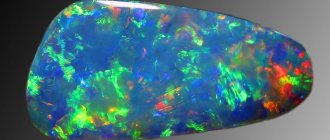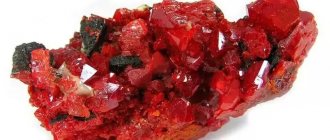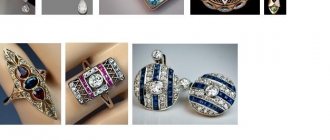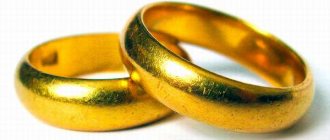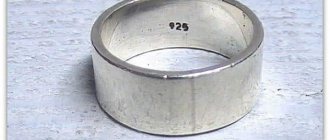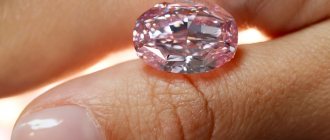Art Nouveau - the paradox of jewelry
At the end of the 19th century, a new style arose in the jewelry world - “Modern”, which immediately conquered the world, striking everyone with its brightness, imagery and decorativeness. This style is characterized by a combination of symbolism and drama; the main motifs are mythological characters, only in the variation in which jewelers see them. A woman who shines in Art Nouveau jewelry is a bright, sophisticated, luxurious and fatal woman, who is called Femme Fatale.
“Modern”, without a doubt, celebrates the symbolism of the passing century, the new role of women in society, as well as the changes that have occurred over the last century. The end of the 19th century is considered a very difficult period in history, which could not but be reflected in the jewelry society. Europe is plagued by turmoil, both economic and political, and at the turn of the century the new movement “Modern” was born.
Just as England can be considered the birthplace of the Art Deco style, France and Russia can be considered the birthplace of the new “Modern” style. This style flourished simultaneously in the two countries listed above, but in Russia, along with the new style, a characteristic national style continues to develop. French jewelers began to look for inspiration not in their native culture, but in the countries of the East, and above all, Japan. The result was a combination of several cultures at once, which is why “Modern” is called the paradox of jewelry.
Among the Russian names, it is necessary to mention Sazikov, Ovchinnikov and Khlebnikov, because it was Russian jewelers who declared themselves loudly, shocking the whole world with jewelry. In 1851, at the London Exhibition, Ignatius Sazikov presented a stunning silver product that combined elements of Art Nouveau and original Russian subjects. After this exhibition, Sazikov’s company began to receive orders from all over the world.
In the jewelry world, Russia began to be taken not just seriously, the country was called the spiritual center of a new direction. However, it is not right to give all the laurels of the “Modern” period only to Russia; France was a successful competitor to our country. The “Modernist” era has been described as the “beautiful era of the bourgeoisie,” where jewelry was a symbol of wealth, prosperity and prosperity.
It is believed that the main source of the Art Nouveau style was a passion for botany; between 1896 and 1900, Eugene Grasset published a number of his works entitled “The Plant and its Use for Ornaments.” Japanese art became another direction of the Art Nouveau style; in 1878, at the International Paris Exhibition, Japanese graphics captivated jewelers, giving rise to a new direction within Art Nouveau. French jewelers and designers actively used Japanese ideas, but the result was a truly French creation.
French historian and jeweler Henri Wever considered the Japanese influence on French jewelers to be so significant that he devoted several pages to it in his book French Jewelry of the 19th Century. One can spend a long time comparing the Russian and French styles of thinking of the Modern era, but there is one undeniable difference: the French turned their attention to Japan and combined the two cultures. Russian master jewelers created a separate branch of the “Modern” style - a national branch that still conquers the world with its originality.
Despite the fact that the Art Nouveau style is associated primarily with luxury and evening wear, jewelry of the late 19th century ceased to be the privilege of only the wealthy class. Jewelers began to create not just clichés, subject to the whims of rich people, but to create true masterpieces that had individuality and taste. Smooth, fluid, asymmetrical forms, refined outlines, and a mystical flavor were evident in Modern jewelry.
If at first floral themes became the main motif of “Modern”, then later mythical motifs, female silhouettes, and natural motifs, such as sea waves, began to be used. The female image became widespread, but not just silhouettes were used, but certain parts of the body: a woman’s swan neck, a chiseled leg, an ideal face...
In conclusion, let's look at the main characteristics of the style. Idea : Russian national color and Japanese culture. Material : any. Motifs : floral, mythical, female image. Shape : smooth lines, asymmetry, sophistication.
Gothic style
Silver necklace from VaeNoxx (vaenoxx.deviantart.com)
The Gothic style in architecture that appeared in the Middle Ages was immediately reflected in jewelry. The products acquired symbolism, became massive and embossed. A play on contrasts began to manifest itself - red stones and blackened silver, black stones and gold.
Today, the Gothic style has many interpretations. Many consider it to be purely youthful, although this is absolutely not the case. Some jewelry is indeed in demand exclusively by representatives of subcultures - “vampire” rings, skulls with diamonds, crosses. But there are also “softer” trends: Gothic Renaissance, jewelry in a contrasting style.
Advertising - Continued below
Classic style (classicism)
Tiara made of gold with diamonds, pearls and enamel, XVIII-XIX centuries.
The style replaced Rococo. Luxury and excessive pretentiousness began to tire people; they wanted simpler and more understandable forms. Thus, in the second half of the 18th century, the classical style arose. The main features are antique ornaments, clear lines, geometric patterns, complete symmetry.
The style lasted only a few decades, but left a visible mark on jewelry. Restrained decor, integrity of forms, simple lines - all this is still popular today. A classic-style ring was either smooth or with an unobtrusive floral or geometric pattern, often with one large stone. By the beginning of the 19th century, decorations began to lose the characteristic features of classicism and again became more magnificent and luxurious. However, it was from the jewelry of the classicism period that modern classical jewelry was born.
Boho style
Boho style jewelry.
Photo: 7colorz.com The style appeared in the 60s of the 20th century during the times of hippies with their free lifestyle. Its features: simplicity, natural materials, layering, pastel natural shades. Boho jewelry often uses ornamental stones, wood and silver. Originality and ethnicity are visible in every product.
High-tech style
Etienne Perret ceramic rings with an outer layer of gold, cobalt and chrome.
The modern high-tech style was born in the second half of the 20th century on the basis of global changes that have occurred to humanity: the acceleration of the rhythm of life, the emergence of new technologies. The form comes first in jewelry, not the material of manufacture and decor. Simple, clear lines, no frills, are becoming popular. Here the incompatible is combined: leather and diamonds of different cut shapes, plastic and silk, plexiglass and gold of different colors.
Despite its brevity, high-tech jewelry can be so original and unexpected that not everyone will dare to wear it.
Art Deco style
Art Deco style ring with diamonds and emeralds.
Photo: romanovrussia.com Masters of the early 20th century were moving away from modernism, making their creations simpler, clearer, and geometric. After the First World War, people needed a holiday, and jewelers reflected it in their creations: Art Deco jewelry acquired brightness and shine, and stone came first.
Advertising - Continued below
In the 20s, the style from France came to the USA and many European countries. Fashionistas fell in love with new models of jewelry in the Art Deco style: “tassel brooches,” long earrings, massive bracelets, brooches with a clip lock. The products had clear geometric lines, large elements, a minimum of curls and small decor, large precious or ornamental stones.
A luxurious kaleidoscope of such decorations can be admired in the popular film “The Great Gatsby”. The official “supplier” of jewelry for the painting was the Tiffany & Co. brand. However, the Art Deco style remains in honor of many famous brands. Harry Winston also produced a collection dedicated to the brilliance of the 20s. Sabine G expressed her love for this style. And how can we not mention the flawless Acte V from Louis Vuitton with its shining diamonds and mirror-polished onyx.
Baroque style
Baroque brooches from Pierre Bex
The great sculptor Michelangelo is considered the “Father” of the Baroque style. The main features of this trend - an abundance of elements, bright colors, lines flowing into each other - are also reflected in the decorations.
Europe in the 17th and 18th centuries was experiencing turmoil. Tired of the tense situation, citizens wanted to somehow get distracted. And so jewelers began to produce the first openwork brooches and buckles with an abundance of pearls, which, by the way, were also used in costumes. By the way, Russia also has its own famous openwork technique - filigree (also known as filigree), which originated in the 10th-12th centuries.
In the Baroque style, previously popular pendants practically disappeared. They were replaced by new models of jewelry - multi-tiered bracelets, “candelabra” earrings, rings with “secrets”.
Advertising - Continued below
Rococo
Gold-plated silver bracelet from Tom Binns
At the beginning of the 18th century, when the unique technique of working with metal “mokume gane” was developing in Japan, the Rococo style reigned supreme in France. It has similar features to the Baroque style, but the Rococo decorations are more fluid and asymmetrical. New elements appear - curls, roundness. The name of the style itself comes from the word “rocaille” - an ornament repeating the curl of a shell.
By the middle of the 18th century, the style spread throughout the cities of Europe. Ladies and gentlemen of those times liked the sophisticated, graceful jewelry, light, ornate. The straight ribbons in the decor became twisted, the leaves became thin and curved, the petals in buds became lush.
Avant-garde style
Licoroso necklace by Sarah Angold
In the second half of the 20th century, a new style appeared - the avant-garde. The main characteristics of jewelry: flexible designs, unusual combinations of materials and color mixing, graphism, non-standard cutting. Now jewelry of the most unexpected shapes and colors became popular, and the more striking they were, the better. Leather and gold, metal and diamonds - all this can be found in one product in the avant-garde style.
Advertising - Continued below
The style has not lost its relevance today: leather bracelets decorated with gold and stones, multi-tiered necklaces, and decor made of clay and enamel are in demand. This style gives complete freedom to the jeweler - he can use any colors, materials, designs, shapes in one piece of jewelry without the risk of seeming unfashionable.
